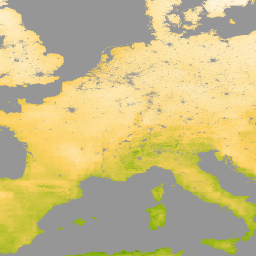
- Dataset-Verfügbarkeit
- 2021-01-01T00:00:00Z–2025-12-03T00:00:00Z
- Dataset-Anbieter
- NASA LP DAAC at the USGS EROS Center
- Intervall
- 8 Tage
- Tags
Beschreibung
Das Produkt MYD16A2 Version 6.1 Evapotranspiration/Latent Heat Flux ist ein 8‑Tage-Composite-Produkt mit einer Pixelauflösung von 500 Metern. Der für die MOD16-Datensammlung verwendete Algorithmus basiert auf der Logik der Penman-Monteith-Gleichung, die Eingaben von täglichen meteorologischen Reanalysedaten sowie MODIS-Fernerkundungsdatenprodukten wie Dynamik der Vegetationseigenschaften, Albedo und Landbedeckung umfasst.
Die Pixelwerte für die Ebenen „ET“, „LE“, „PET“ und „PLE“ sind die Summe für alle Tage im 8‑Tage-Zeitraum.Der letzte 8‑Tage-Zeitraum jedes Jahres ist je nach Jahr ein 5‑ oder 6‑Tage-Zeitraum.
Die Level-1B-Produkte (L1B) der Version 6.1 wurden durch verschiedene Kalibrierungsänderungen verbessert, darunter Änderungen am Ansatz für das Verhältnis von Reaktion und Scanwinkel (Response-versus-Scan, RVS), der sich auf die Reflexionsbänder für Aqua und Terra MODIS auswirkt, Korrekturen zur Anpassung an das optische Übersprechen in den Infrarotbändern (IR) von Terra MODIS sowie Korrekturen für die Aktualisierung der Forward-Look-up-Tabelle (LUT) von Terra MODIS für den Zeitraum 2012 bis 2017. Auf die reflektiven Solarbänder (Reflective Solar Bands, RSB) der L1B-Ebene wurde eine Polarisationskorrektur angewendet. Das Produkt verwendet die Klimatologie-LAI/FPAR als Backup für die operative LAI/FPAR.
Laut MODIS Science Team sind für das Produkt MYD16A2 6.1 keine Daten vor 2021 verfügbar. Das MODIS-Wissenschaftsteam empfiehlt, das lückenlose Produkt MYD16A2GF 6.1 für Daten von 2000 bis 2021 und dann auch für 2022 zu verwenden, sobald die Daten verfügbar sind. Sie empfehlen dies, da das Produkt mit Lückenfüllung voraussichtlich eine höhere Produktqualität aufweist, insbesondere in Bereichen, in denen die Leistung des regulären Produkts ansonsten durch wolkige oder qualitativ schlechte Eingabebeobachtungen negativ beeinträchtigt worden wäre. Für das laufende Jahr wird es erst Anfang des Folgejahres ein Produkt mit Lückenschluss geben (d.h. Daten für 2023 sollten Anfang 2024 verfügbar sein). Wenn ein Nutzer also MYD16A2GF 6.1-Daten für das Jahr 2023 (oder das „aktuelle“ Jahr in der Zukunft) benötigt, wird empfohlen, das Produkt MYD16A2 6.1 zu verwenden, das aus der täglichen Beobachtung mit Klimatologiebeobachtung generiert wird, die für die bewölkten oder minderwertigen Beobachtungen ersetzt wird.
Dokumentation:
Bänder
Pixelgröße
500 Meter
Bänder
| Name | Einheiten | Min. | Max. | Maßstab | Pixelgröße | Beschreibung | |||||||||||||||||||||||||||||||||||||||||||||||||||||||||||||||||||||||||||||||||||||||||||||
|---|---|---|---|---|---|---|---|---|---|---|---|---|---|---|---|---|---|---|---|---|---|---|---|---|---|---|---|---|---|---|---|---|---|---|---|---|---|---|---|---|---|---|---|---|---|---|---|---|---|---|---|---|---|---|---|---|---|---|---|---|---|---|---|---|---|---|---|---|---|---|---|---|---|---|---|---|---|---|---|---|---|---|---|---|---|---|---|---|---|---|---|---|---|---|---|---|---|---|---|
ET |
kg/m^2/8day | -32767 | 32700 | 0,1 | Meter | Gesamte Evapotranspiration |
|||||||||||||||||||||||||||||||||||||||||||||||||||||||||||||||||||||||||||||||||||||||||||||
LE |
J/m²/Tag | -32767 | 32700 | 10000 | Meter | Durchschnittlicher latenter Wärmefluss |
|||||||||||||||||||||||||||||||||||||||||||||||||||||||||||||||||||||||||||||||||||||||||||||
PET |
kg/m^2/8day | -32767 | 32700 | 0,1 | Meter | Potenzielle Gesamtevapotranspiration |
|||||||||||||||||||||||||||||||||||||||||||||||||||||||||||||||||||||||||||||||||||||||||||||
PLE |
J/m²/Tag | -32767 | 32700 | 10000 | Meter | Durchschnittlicher potenzieller latenter Wärmestrom |
|||||||||||||||||||||||||||||||||||||||||||||||||||||||||||||||||||||||||||||||||||||||||||||
ET_QC |
Meter | Flags für die Qualitätskontrolle der Evapotranspiration |
|||||||||||||||||||||||||||||||||||||||||||||||||||||||||||||||||||||||||||||||||||||||||||||||||
Bildattribute
Bildeigenschaften
| Name | Typ | Beschreibung |
|---|---|---|
| num_tiles | INT | Die Anzahl der Quellkacheln, die für die Erstellung dieses Bildes zusammengefügt wurden. |
Nutzungsbedingungen
Nutzungsbedingungen
Für MODIS-Daten und ‑Produkte, die über das LP DAAC bezogen werden, gelten keine Einschränkungen für die spätere Nutzung, den Verkauf oder die Weitergabe.
Zitationen
Informationen zum Zitieren von LP DAAC-Datasets finden Sie auf der LP DAAC-Seite „Citing Our Data“.
DOIs
Die Earth Engine nutzen
Code-Editor (JavaScript)
var dataset = ee.ImageCollection('MODIS/061/MYD16A2') .filter(ee.Filter.date('2021-01-01', '2021-02-01')); var evapotranspiration = dataset.select('ET'); var evapotranspirationVis = { min: 0.0, max: 300.0, palette: [ 'ffffff', 'fcd163', '99b718', '66a000', '3e8601', '207401', '056201', '004c00', '011301' ], }; Map.setCenter(6.746, 46.529, 2); Map.addLayer( evapotranspiration, evapotranspirationVis, 'Evapotranspiration');
